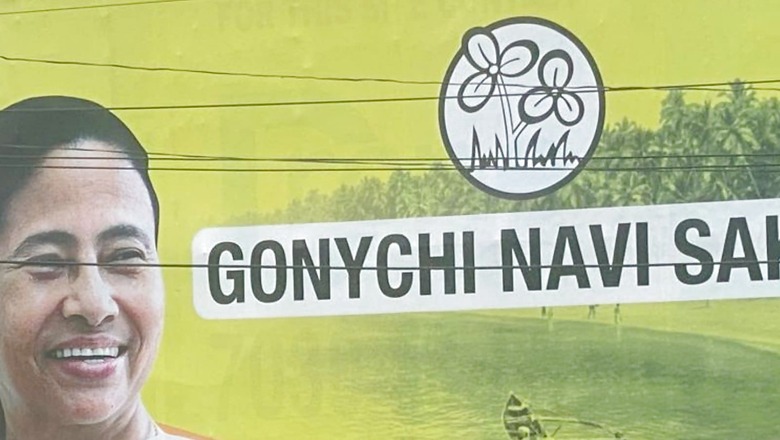
views
After the Nationalist Congress Party and the Shiv Sena from neighbouring Maharashtra, which had limited electoral success in tiny Goa, and the grand failure of the Aam Aadmi Party despite a high-octane campaign last time, it is the turn of the Trinamool Congress to now try out its luck in this sylvan coastal state.
Why Goa? It has only two seats in the Lok Sabha and the smallest of Assemblies and can in no way add significantly to any party’s numbers either in the Lok Sabha or the Rajya Sabha. But there are some obvious advantages for an alien regional party to try and breach the state. The foremost of these is that Goa, despite a couple of breakaway factions, essentially continues to be a two-party state with just the Congress and the ruling BJP, evenly matched with each other. There is hardly any regional party to speak about after the marginalisation of the Maharashtrawadi Gomantak Party (MGP), which ruled Goa for nearly two decades after its annexation from the Portuguese and its integration with independent India.
The MGP represented mostly non-upper caste and poorer Hindus who got a raw deal under the Portuguese but then the advent of the Congress and some years later the BJP had neatly carved up the substantial Christian and minority populations and the Hindu voters among themselves, a battle being carried out between the two parties even today.
As its name suggests, the MGP leaned towards Maharashtra but its Christian population fiercely opposed the state’s merger into the larger state—its two Lok Sabha seats combined are not even the size of perhaps the smallest Assembly constituency in Maharashtra and zilla parishads in the neighbouring state often elect more members than the Goa Assembly. Many other Goans too while not inimical to Maharashtra did not wish for a submerging of their identity and wanted to retain their own unique culture and ethos.
ALSO READ | ‘In Goa, Cong is Credible But Not an Option, AAP an Option But Not Credible; Right Time for TMC’: Derek
Why Goa?
The Shiv Sena which is a strong political force across the contiguous districts of the Konkan, which shares a common language with the Goans, has been unable to win a single seat here over the years and the NCP has managed only the occasional seat in alliance with the Congress.
All parties, including the Sena and the NCP, have had national ambitions but to be recognised as a national party with its own symbol—the Sena shares its bow-and-arrow with the Jharkhand Mukti Morcha—constitutionally, a party must have at least 2 per cent representation in the Lok Sabha from four states, polls 6 per cent of valid votes in the Assembly or Lok Sabha in at least four states and has at least four MPs from any state.
The NCP is one of the few parties that have managed this feat, electing MLAs to a couple of Northeastern states, Kerala, Gujarat and Goa with strategic alliances with local parties. But when Sharad Pawar found that his adventurous break-off with the Congress might jeopardise his party’s national status and party symbol, he promptly traced his steps back to the mother party and stayed with them, however discontented or dissatisfied.
However, Goa’s tiny geography and the need for fewer resources in contesting an election here make it an attractive destination. Language is no barrier either for most Goans speak English and understand Hindi even if Portuguese is still popular and Marathi or Konkani is their mother tongue. Contrast this with Gujarat, another two party-ruled state, where too the AAP tried to break in but failed to make the cut. The TMC already seems to have wooed over senior Goa Congress leader Luizinho Faleiro to its camp and perhaps hopes it has a fair chance of winning a couple of seats.
It is also obvious that those leaders taking their parties to Goa, Punjab or other states also have prime ministerial ambitions and they must begin to break the shackles of a regional party somewhere. Goa, they believe, will be the easiest because of its size, lack of competitors and not too many language barriers. However, like the Congress and the MGP, even the TMC has positioned itself as a centrist party, so at best it could take away votes from the Congress, adding to the BJP’s advantage.
Not Easy to Make Inroads
However, despite the advantages, it might not be quite easy for an outsider to make inroads into Goa. While the BJP has lost a highly charismatic leader in Manohar Parrikar and the Congress might wish to stay with the uncharismatic Digambar Kamat, a former chief minister, the areas of discontent for Goans regarding mining, pollution, tourism, education and language policies are many. The last time round the Congress was caught napping despite a slender lead over the BJP, which moved swiftly to form the government. The people of Goa might not wish to experiment with a new kid on the block and given the state’s demographics and burning issues either party stands a fair chance at winning an outright majority this time round.
But one must begin somewhere and Goa is as good a state as any for the Trinamool Congress, the AAP or anyone else.
Sujata Anandan is a senior journalist and is the author of Samrat: How the Shiv Sena Changed Mumbai Forever. The views expressed in this article are those of the author and do not represent the stand of this publication.
Read all the Latest News , Breaking News and IPL 2022 Live Updates here.
















Comments
0 comment